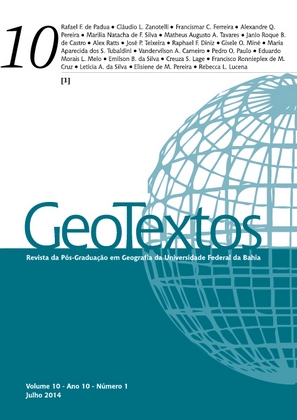“AFOXÉ AXÉ OMO ODÉ”: THE “CANDOMBLÉ STREET” IN GOIÂNIA
DOI:
https://doi.org/10.9771/1984-5537geo.v10i1.9268Keywords:
Afoxé, Candomblé, CarnivalAbstract
In this article we present the afoxé as cultural expression and spatial, the relations between the terreiro (Afro-Brazilian temple) and the city, and, finally, the link between some black cultures. This communication is the result of two complementary researches: one that focuses on the relationship between candomblé and public space, which in turn is part of the research project “Black trajectories and territorialities “. The afoxés are carnival groups, linked to Afro-Brazilian religions, particularly the candomblé, and exist throughout the national territory, with a concentration in the States of Bahia and Pernambuco. The Afoxé Axé Omo Odé, da cidade de Goiânia, State of Goiás, created in 1990 and reconstituted in 2008 seems to be related to a process of affirmation of these religions and other cultures black as capoeira and congada. In their routes the afoxé becomes a mobile territory and contributes to establish and consolidate “geo-symbols” in the city.Downloads
Downloads
Published
How to Cite
Issue
Section
License
Autores que publicam nesta revista concordam com os seguintes termos:
Autores mantém os direitos autorais e concedem à revista o direito de primeira publicação, com o artigo simultaneamente licenciado sob a Licença Creative Commons Creative Commons CC BY que permite o compartilhamento do trabalho com reconhecimento da autoria e publicação inicial nesta revista. Esta licença permite que outros distribuam, remixem, adaptem e criem a partir do seu trabalho, mesmo para fins comerciais, desde que lhe atribuam o devido crédito pela criação original. É a licença mais flexível de todas as licenças disponíveis. É recomendada para maximizar a disseminação e uso dos materiais licenciados. Ver o resumo da licença em: https://creativecommons.org/licenses/by/4.0/ Ver o texto legal da licença em: https://creativecommons.org/licenses/by/4.0/ Consulte o site do Creative Commons: https://creativecommons.org/licenses/?lang=pt
Autores têm autorização para assumir contratos adicionais separadamente, para distribuição não-exclusiva da versão do trabalho publicada nesta revista (ex.: publicar em repositório institucional ou como capítulo de livro), com reconhecimento de autoria e publicação inicial nesta revista.
Autores têm permissão e são estimulados a publicar e distribuir seu trabalho online (ex.: em repositórios institucionais ou na sua página pessoal) a qualquer ponto antes ou durante o processo editorial, já que isso pode gerar alterações produtivas, bem como aumentar o impacto e a citação do trabalho publicado (Veja O Efeito do Acesso Livre).






